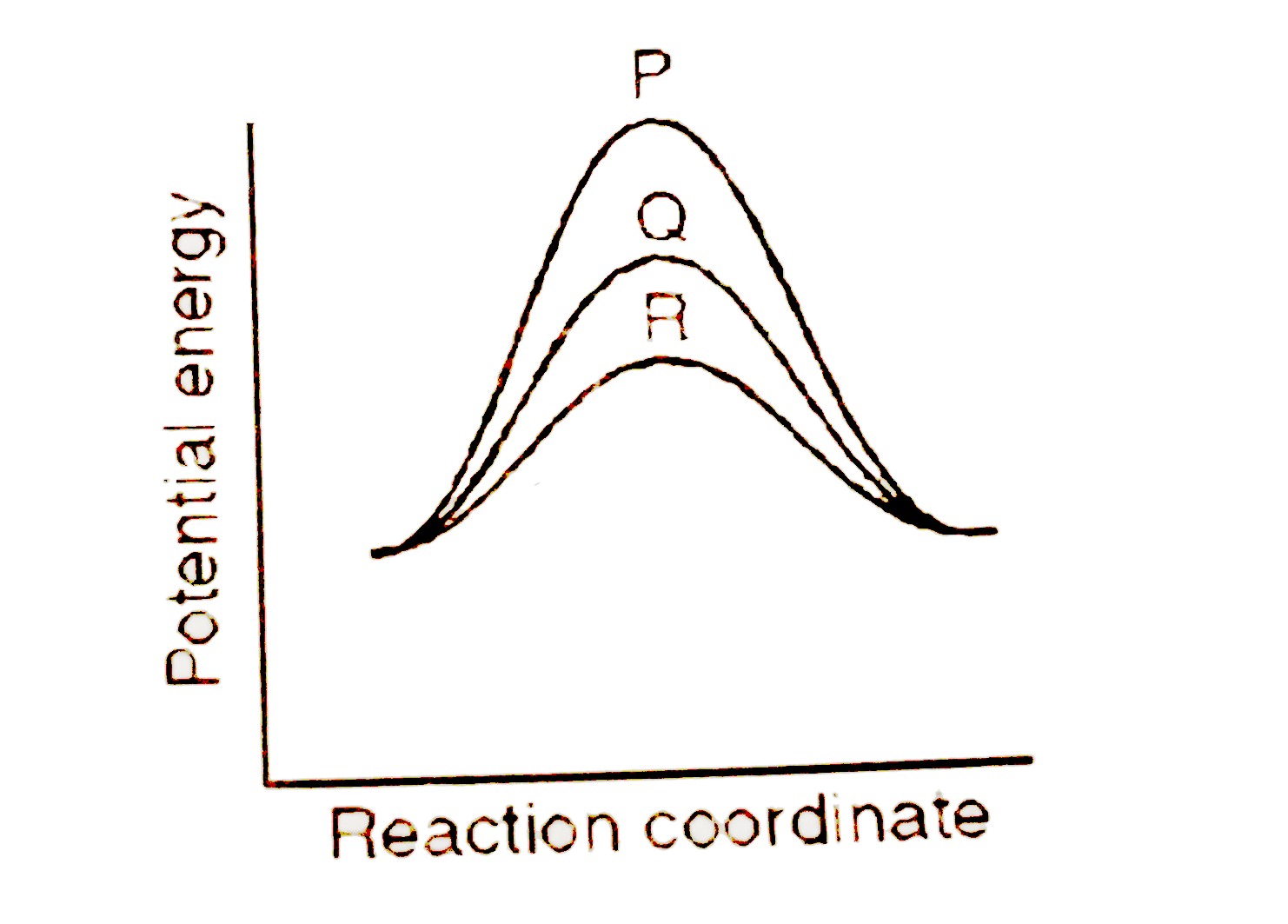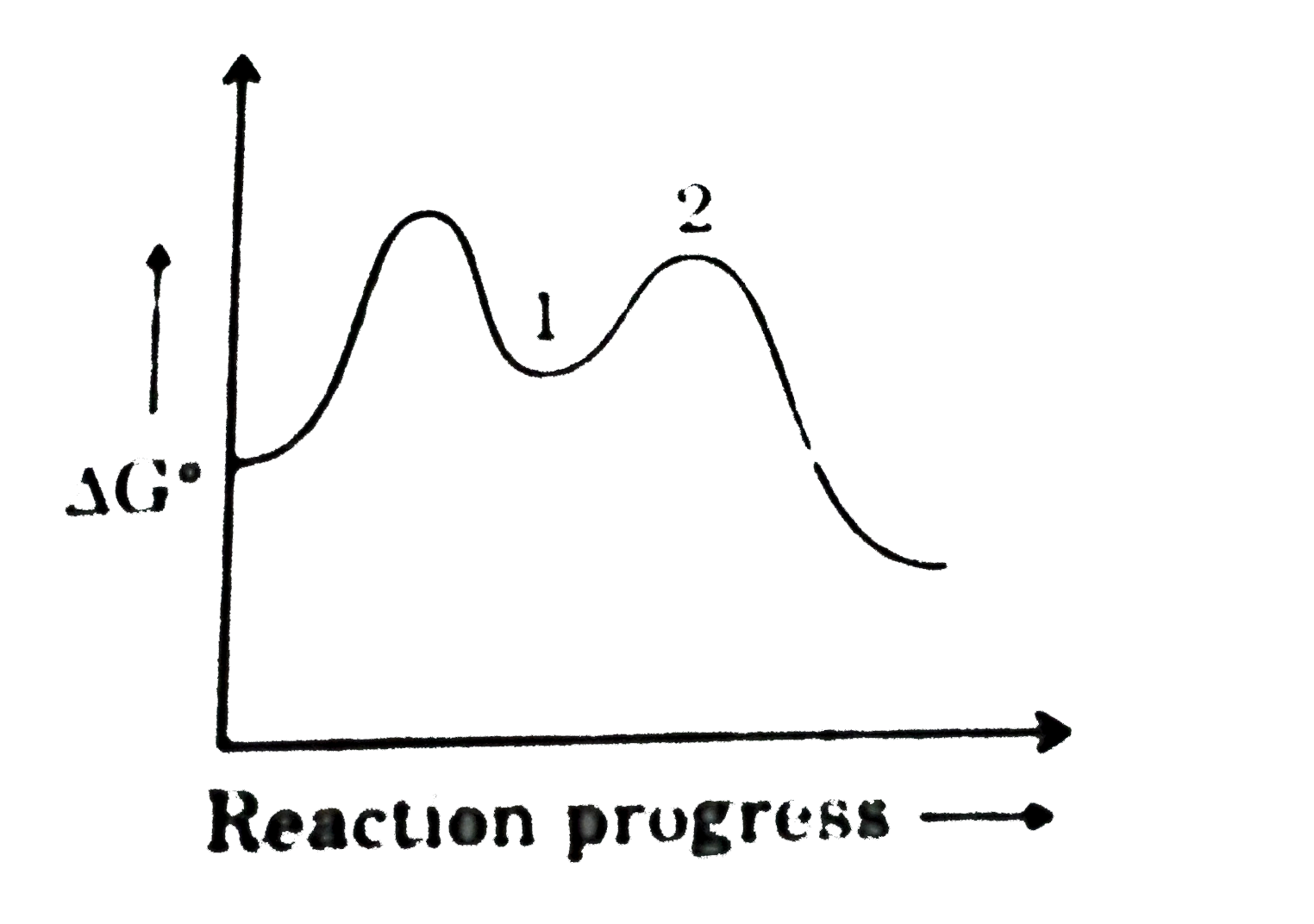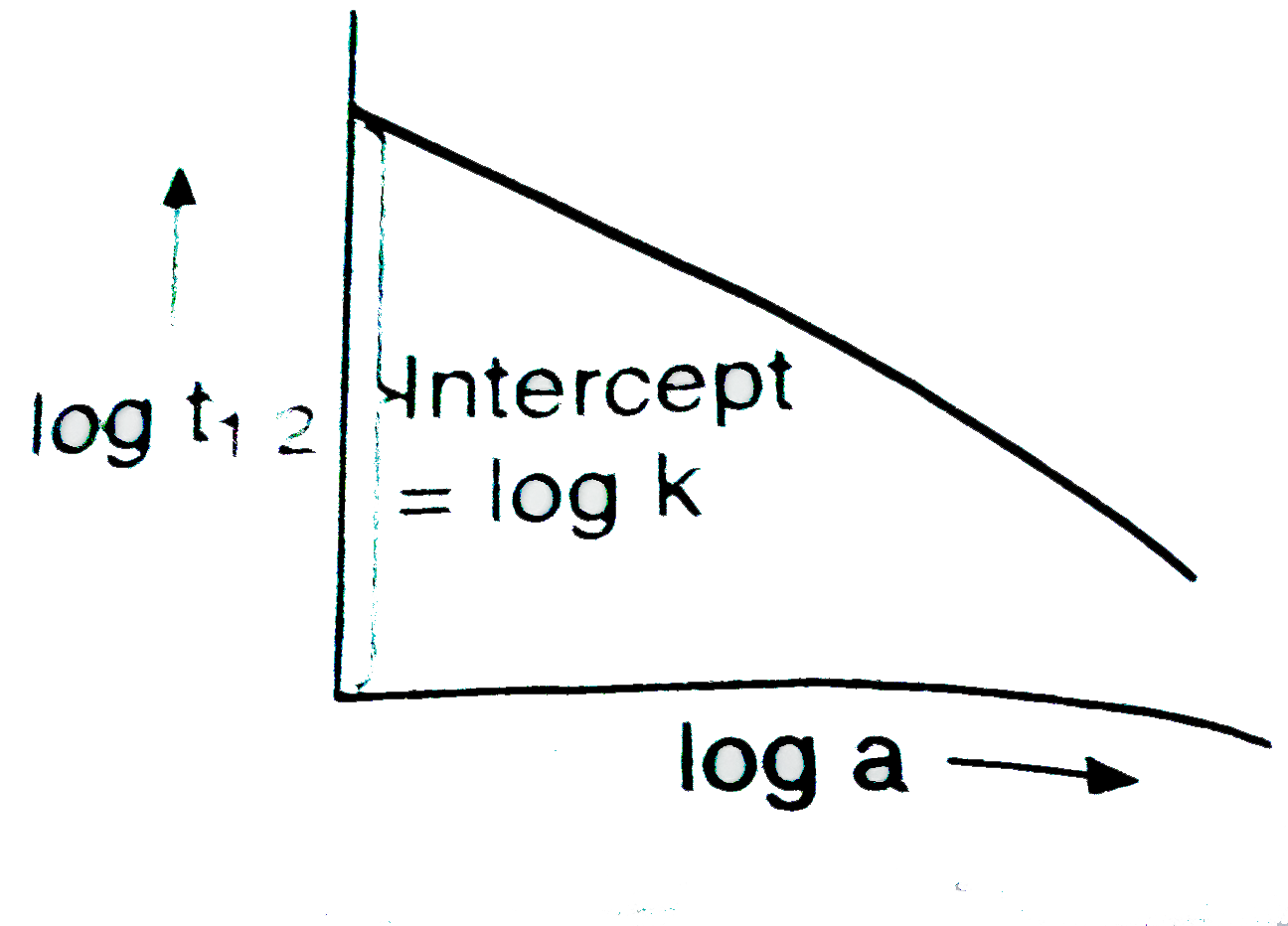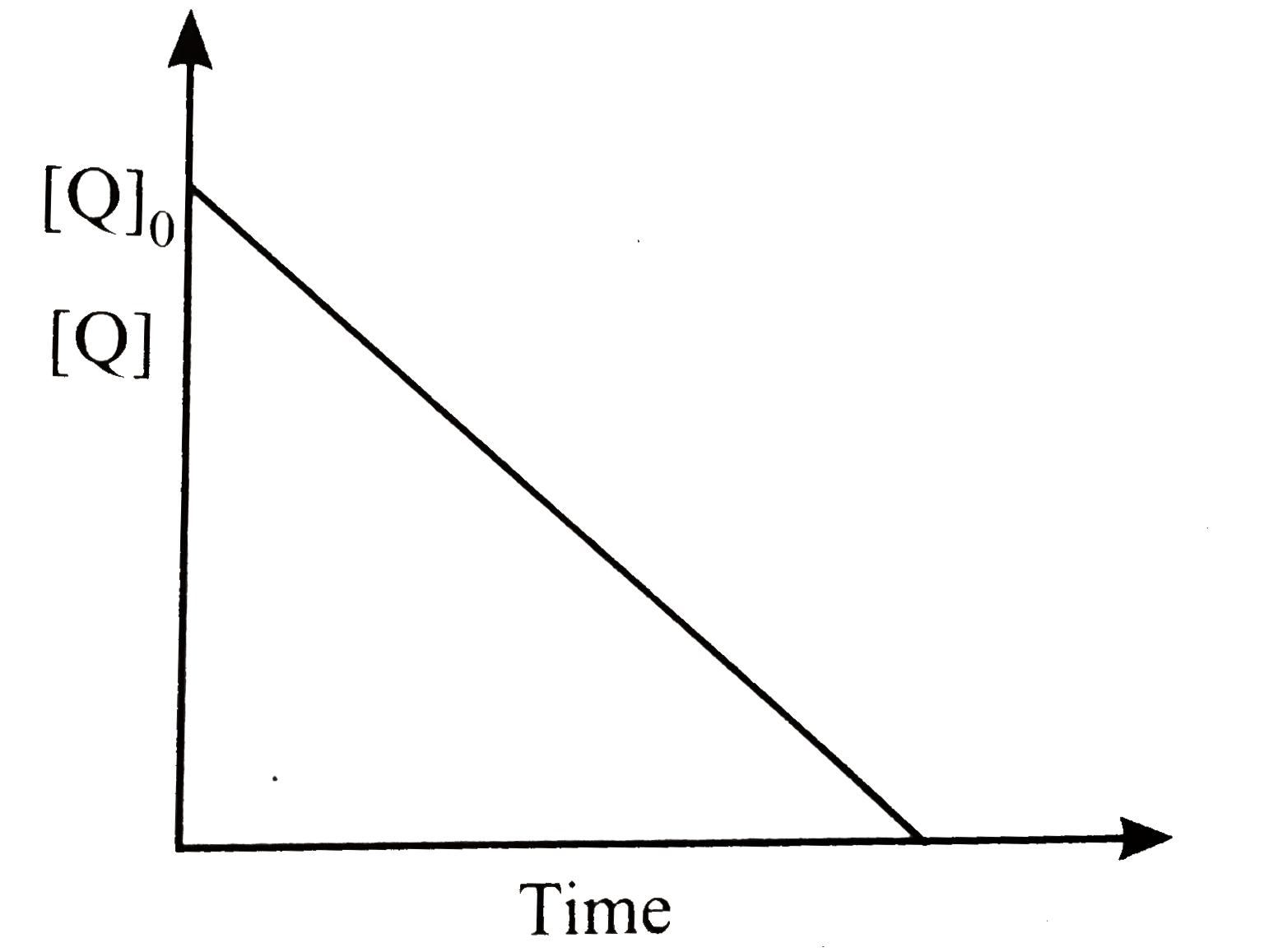Complete Solutions to OBJECTIVE QUESTIONS (LEVEL-B) SET I of chapter CHEMICAL KINETICS of Class 12 book with complete answers and questions
| Class 12 | CHEMISTRY |
| Chapter | CHEMICAL KINETICS |
| OP TANDON | OBJECTIVE QUESTIONS (LEVEL-B) SET I |
| Number Of Questions | 48 |
| Academic Year | 2023-24 |
Which of the following is correct ?
View SolutionThe rate constant of the reaction
`2H_(2)O_(2)(aq) rarr 2H_(2)O(l) + O_(2)(g)` is `3 xx 10^(-3) min^(-1)`
At what concentration of `H_(2)O_(2)`, the rate of the reaction will be `2 xx 10^(-4) Ms^(-1)` ?
View SolutionThe mechanism of the reaction
`2NO(g)+H_(2)(g)rarrN_(2)(g)+2H_(2)O(g)`, is:
Step1: `2NO(g)+H_(2)(g)overset(("slow"))rarrN_(2)+H_(2)O_(2)`
Step2: `H_(2)O_(2)+H_(2)overset("fast")rarr2H_(2)O`
View SolutionConsider following two competing first ordr reactions,
`Poverset(k_(1))rarrA+B,Qoverset(k_(2))rarrC+D`
if `50%` of the reaction oof P wascompleted when `96%` of Q was complete ,then the ratio `(k_(2)//k_(1))` will be :
View SolutionThe reaction `Aoverset(k)rarr` Product, is zero order while the reaction `Boverset(k)rarr` Product, is first order reaction. For what intial concentration of A are the half lives of the two reacions equal?
View SolutionWhich of the following is pseudo-unimolecular reaction ?
View SolutionThe order and molecularity of the chain reaction,
`H_(2)(g)Cl_(2)(g)overset(kv)rarr2HCl(g)`are :
View SolutionA reactant `(A)` forms two products
`A overset (k_(1))rarr B`, Activation energy `E_(a1)`
`A overset (k_(2))rarr C`, Activation energy `E_(a2)`
If `E_(a_(2)) = 2E_(a_(1))` then `k_(1)` and `k_(2)` are related as
View SolutionCollision theory is satisfactory for:
View SolutionInitial concentration of reactant for nth order reaction is 'a'. Which of the following relations is correct about `t_(1//2)` of the reaction?
View SolutionHalf life of a reaction becomes half when intial concentrations of reactants are made double. The order of the reaction will be:
View SolutionArrehnius equation is :
`k=Ae^(-E_(a)//RT)`
Which of the following graphs represents the variation of rate constant k against temerature T?
View SolutionIf a homogeneous catalytic reaction can take place through three alternative paths as depicted below, the catalytic efficiency of P,Q R representing the relative case would be

View SolutionThe rate constant for the reaction:
`2N_(2)O_(5) rarr 4NO_(2)+O_(2)` is `3.0xx10^(-5) sec^(-1)`. If the rate is `2.40xx10^(-5) M sec^(-1)`, then the concentration of `N_(2)O_(5)` (in M) is:`
View SolutionConsider the following statement :
1 The rate of reaction is always proportinal to the concentration of reactants.
2 The order of an elementary chemical reaction step can be determined by examing its stoichimoetry.
3 The first order reactions follows an exponential time course.
Of these statements :
View SolutionTwo different first order reactions have rate consants `k_(1) and k_(2) "at" T_(1)(k_(1)gtk_(2))` . If temperature is increased form `T_(1) "to"T_(2)` ,then new consant become `k_(3) and k_(4)` respeectively. Which among the following relartions is correct
View SolutionIn the reaction `A+BrarrC+D`, the rate `((dx)/(dt))` when plotted against time 't' gives a straight line parallel to time aixs.
The order and rate of reaction will be:
View SolutionIn the hober's process of ammonia manufacture,
`N_(2)(g)+3H_(2)(g) rarr2NH_(3)(g)`
the rate of appearance of `NH_(3)` is :
`(d[NH_(3)])/(dt)=2xx10^(-4)"mol" L^(-1)"sec"^(-1)`
The rates of the reaction expressed in terms of `N_(2) and H_(2)` will be :
View SolutionA reaction `ArarrB` , involes following mechanism :
Step1 : `Aoverset(k_(1))rarrB" "("fast")`
Step2 : `Boverset(k_(2))rarrC " "("slow")`
Step3: `Coverset(k_(3))rarrD " "("fast")`
The rate law of the reaction may be given as :
View SolutionFor a gaseous reaction, the following data were recorded :

The order of reaction is :
View SolutionThe half of second order reactin is :
View SolutionWhat names apply to chemical species corresponding to locations 1 and 2 on this reaction coordiante diagram ?

View SolutionConsider this reaction :
`2NO_(2)(g)+O_(3)(g)rarrN_(2)O_(5)(g)+O_(2)(g)`
The reaction of nitrogen diozidd and ozone represented is first order in `NO_(2)(g) and "i n" O_(3)(g)`. Which of these possible reaction mechanisms is consistent with the rate law?
Mechanism I: `NO_(2)(g)+O_(3)rarrNO_(3)(g)+O_(2)("slow ")`
`NO_(3)(g)+NO_(2)(g) rarrN_(2)O_(5)(g)" "("fast")`
Mechanism II `O_(3)(g)hArrO_(2)(g)+[O]" "("fast")`
`NO_(3)(g)+[O](g)rarrNO_(3)(g)" "("slow")`
`NO_(3)(g)+NO_(2)(g)rarrN_(2)O_(5)(g)" " ("fast")`
View SolutionUse the experimental data in the table to determine was studies

What is the rate equation for the reaction ?
View SolutionIn which of the following reactions, the increase in the rate of reaction will be maximum?
View SolutionWhich of the reactions represented in these diagrams will show the greatest increase in rate for the same increase in temperature ?

View SolutionWhich function of [X] . Polleted against time, will give a straight line for a second order reaction ?
`Xrarr"Products"`
View SolutionDecomposition of `H_(2)O_(2)`, is a first order reaction. A 16 volume solution of `H_(2)O_(2)` of half life 30 min is present at start. When will the solution become one volume?
View SolutionWhat is the activation energy for the reverse of this reaction?
`N_(2)O_(4)(g)rarr2NO_(2)(g)`
Data for the given reaction is `: DeltaH=+54 kJ and E_(a)=+57.2kJ:`
View SolutionThe reaction between chloroform, `CHCl_(3)(g)` and chlorine `Cl_(2)(g)` to from `C Cl_(4)` is believed to occur by this series of steps :
Step1 : `Cl_(2)(g)rarrCl(g)+Cl(g)`
Step2 : `CHcl_(3)(g)+Cl(g)rarrC Cl_(3)(g)+HCl(g)`
Step3 : `C Cl_(3)(g)+Cl(g)rarrC Cl_(4)(g)`
If this reaction is first order in `CHcl_(4)` and half order in `Cl_(2)` which statement about the relative rates of steps 1,2 and 3 is correct?
View SolutionIn the reaction,
`3BrO^(-)rarrBrO_(3)^(-)+2Br^(-)` (aqueous alkaline medium at `80^(@)C`) the vlaue of the rate constant in the rate law in terms of `--(d)/(dt)[BrO^(-)]` is `0.056 L "mol"^(-1)s^(-1)`. What will be the rate constant when the law is stated in terms of `(d)/(dt)[BrO^(-)]`?
View SolutionWhich of the following graphs is correct for the following reaction?
`CH_(3)-CH_(2)CH=CH_(2)underset(300^(@)C)overset(H_(2)//Ni)rarrCH_(3)-CH_(2)-CH_(2)-CH_(3)`
View SolutionThe activation energy of a certain reaction is 87 kJ `"mol"^(-1)`. What is the ratio of the rate constants for this reaction when the temperature is decreases from `37^(@)C"to"15^(@)C`?
View SolutionConsider the reaction :
`2H_(2)(g)+2NO(g)rarrN_(2)(g)+2H_(2)(g)`
The rate law for this reaction is :
Rate = `k[H_(2)][NO]^(2)`
Under what conditions could these steps represent mechanism?
`{:("Step 1:",2NO(g)hArrN_(2)O_(2)(g)),("Step 2:",N_(2)O_(2)+H_(2)rarrN_(2)O+H_(2)O),("Step 3:",N_(2)O+H_(2)rarrH_(2)O+N_(2)):}`
View SolutionPropane reacts with iodine in acid medium accroding to the following equation:
`CH_(3)-overset(O)overset(||)C-CH_(2)+I_(2)overset(H^(+))rarrCH_(3)-overset(O)overset(||)C-CH_(2)I+HI`
These data were obtained when the reaction was studied :

What is the rate equation for the reaction?
View SolutionArrhenius equation `k=Ae^(-E_(a)//RT)`
If the activation energy of the reaction is found to be equal to RT then,
View SolutionAt `25^(@)C` , the values of rate constant activation energy and Arhenius constant of a raction ar `3xx10^(-4)"sec"^(-1)`, 129k/J mol and `2xx10^(15)"sec"^(-1)` respectively .
The value of rarte constant as `Trarroo` is :
View SolutionThe observed rat of acemical reaction is substantially lower than the collision frequecy. One or more of the following statements is/are true to account for this fact.
A. The reactants to do not have the required energy
B. The partnes do not collide in the proper orientation
(C) Collision complex eists for a very short time.
D. Collision frequecny over estimates the number of effective collisions.
View SolutionThe reaction between NO and `Cl_(2)` takes place in the following two steps :
I `{:(" "k_(1)), (NO + Cl_(2) hArr NOCl_(2)), (" "k_(2)), (" ""fast"):}`
II. `NOCl_(2)underset("fast")overset(k_(2))rarr2NOCl`
The rate law of overall reaction,
`2NO+Cl_(2)to2NOCl` can be given by:
View Solutionwhich of the following reactions will not have fractional order for `A_(2) or B_(2)`?
View SolutionIn which of the following, `E_(a)` for backward reaction is greater than `E_(a)` for forward reaction?
View SolutionFor n th order reaction `(t_(1//2))/(t_(3//4))` depends on `(n ne1)` :
View SolutionFor a second order reaction, `2Ararr` Products, a plot of log `t_(1//2)` vs log a (where a is initial concentration) will give an intercept equal to which one of the following?

View SolutionFor a reaction taking place in three steps, the rate consatnt are `k_(1),k_(2) and k_(3)`. The oveall constant `k=(k_(1)k_(2))/(k_(3)` . If the energy of activation values of for the first, second and third stage are 40,50 and 60 kJ `"mol"^(-1)` is :
View SolutionFor an exothermic chemical process ocuuring in two process occuring in two steps as follows
`(i)A+BtoX("slow")" "(ii)XtoAB("fast")`
The progress of reaction can be best described by :
View SolutionA reaction takes place in three steps with individual rate constant and activation energy,
`{:(,"Rate constant","Activation energy"),("Step 1",k_(1),E_(a_(1))=180kJ //"mol"),("Step2", k_(2),E_(a_(2))=180kJ //"mol"),("Step3",k_(3),E_(a_(3))=180kJ //"mol"):}`
oveall rate constant, `k=((k_(1)k_(2))/(k_(3)))^(2//3)` overall activation energy of the reaction will be :
View SolutionIn the reaction, `P+Q rarr R+S`
the time taken for `75%` reaction of `P` is twice the time taken for `50%` reaction of `P`. The concentration of `Q` varies with reaction time as shown in the figure. The overall order of the reaction is

View SolutionFor the elementary reaction `MrarrN`, the rate of disappearance of `M` increases by a factor of `8` upon doubling the concentration of `M`. The order of the reaction will respect to `M` is
View Solution
OBJECTIVE QUESTIONS (LEVEL-B) SET I questions and complete solutions for chapter CHEMICAL KINETICS of G.R. BATHLA & SONS CHEMISTRY (HINGLISH) of Class 12
All Exercises from OP TANDON Class 12 CHEMISTRY CHEMICAL KINETICS
- ASSERTION- REASON TYPE QUESTIONS
- EXAMPLE
- ILLUSTRATIONS
- INTEGER ANSWER TYPE QUESTIONS
- INTEGER ANSWER TYPE QUESTIONS (SECTIN-V)
- LINKED COMPRESHENSION TYPE QUESTIONS ( SECTION-VI)
- MATRIX -MATCHING TYPE QUESTIONS (SECTION-IV)
- MATRIX MATCHING TYPE QUESTIONS
- OBJECTIVE QUESTIONS (LEVEL-A)
- OBJECTIVE QUESTIONS (LEVEL-B) SET I
- OBJECTIVE QUESTIONS (LEVEL-B) SET II
- PASSAGE -1
- PASSAGE -2
- PASSAGE -3
- PASSAGE -4
- PASSAGE -5
- PRACTICE PROBLEMS
- SELF ASSESSMENT (SECTION-I)
- SELF ASSESSMENT (SECTION-II)